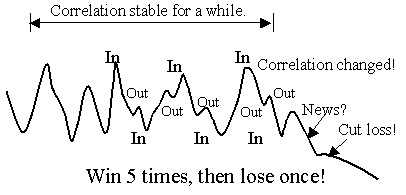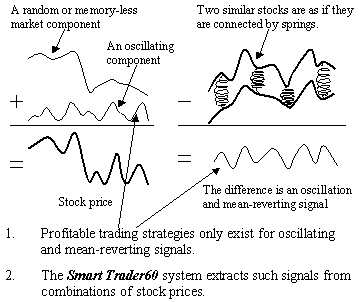|
Market Neutral Strategy
Market Neutral Strategies are especially suitable for today’s highly volatile and
uncertain market environment. In the next section, we introduce a market-neutral
relative value trading strategy that consistently generates attractive returns
at relatively low risk. According to our extensive statistical analyses and historical
tests, this strategy can produce a yearly return of 60% +- 17%. AASTOCKS's
real-time trading system can provide up-to-the-minute equity trading buy/sell signals.
Our Market-Neutral Pairtrade Model on AASTOCKS.com is a web-based version of
this system. We call it Smart Trader 60.
Why does the strategy
work?
The SMART TRADER 60system has evolved from the well-known
correlation/convergence trading strategy (also called statistical
arbitrage), which is widely employed by major Wall Street firms, hedge
funds, and sophisticated independent investors to make profits without taking
significant directional risks. The strategy focuses on liquid price signals
that are strongly correlated. The chart in Figure 26 explains the basic idea of
correlation/ convergence trading.

- Construct non-trending price signals based on correlation analysis
- Buy lows and sell highs
- Cut losses if trades lose more than set targets
|
Figure 25(a). The conventional convergence trading and statistical arbitrage system.
The more advanced SMART TRADER 60 system is based on
correlation analyses, pattern recognition and stochastic control theory. It overcomes a
few of the main drawbacks of conventional correlation/convergence trading strategies. For
example, it is smart enough to eliminate (or reduce) fortuitous correlation and it
dynamically detects drift directions from the stochastic price signals. As a result, it
performs much more efficient than the conventional correlation/convergence trading
systems.
AASTOCKS.com's more-advanced SMART TRADER 60 system is based on
correlation analyses, pattern recognition, and stochastic control theory. By so
combining these information patterns, we overcome a few of the main drawbacks that
undercut conventional correlation/convergence trading strategies. For example,
Smart Trader 60 is smart enough to eliminate or reduce misleading
fortuitous correlation; it can also dynamically detect drift predictors from
stochastic price signals. As a result, it performs much more efficiently than
conventional correlation/convergence trading systems.
Making a profit consistently by trading individual stocks is difficult: the
main component of the price signal is memory-less and overwhelmingly large. It iseasier to make profits by trading in accord with the oscillating
rhythmic component or the fluctuating elastic signal in the price differentials of
two or more stocks. To overcome the distorting influence of the large random
market signal, we structure a combination of trading positions in a pair or a
group of similar stocks so that the random market-signal components of all the
stocks in the overall trading position are canceled out. This leads to an
oscillating and mean reverting price signal, which can be easily read for trading
cues: buy lows and sell highs.
| Profitable trading strategies exist if you do it right! |

Figure 25(b). Smart Trader 60 uses a combination of stock profiles such as
taking long and
short
positions to eliminate the random, memory-less component;
thus, we are left with oscillating and mean reverting signals that more reliably
indicate profitable trades.
The charts in Figure 27 explains how stock prices behave and provides
guidelines for structuring profitable trades. Smart Trader 60 is specifically
designed to discern and highlight price signals that are oscillating and mean-
reverting, so that profit-generating AASTOCKS traders need only to buy lows and sell highs according to a given set of optimal entry and exit
strategies.
|
